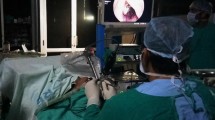Abstract
To study the specific effects of smoking on laryngeal mucosa and voice using video-stroboscopy, subjective and objective voice analysis. This cross-sectional and observational study was carried out in the Department of Otorhinolaryngology, M.G.M. Medical College & M.Y. Hospital, Indore on 103 subjects with dysphonia (49 smokers and 54 non-smokers), between October 2018 to October 2020. After detailed history and general examination, all the cases underwent video-stroboscopic analysis and voice analysis by simple parameters—Maximum Phonation Time (M.P.T.) & s/z score. The cases answered the Voice Related Quality Of Life questionnaire (V.R.Q.O.L.). The observations between smokers and non-smokers were compared. Statistically significant (P < 0.05) associations were observed between smoking and various vocal fold pathological characteristics. There was statistically significant association of smoking with overall possibility of benign vocal fold lesions (P = 0.0129). Significant association was noted of smoking with specific lesions like leukoplakia (P = 0.02), erythema (P = 0.0161) and Reinke’s edema (P = 0.322). The mean M.P.T. was 9.5 s in smokers and 11 s in non-smokers. We observed statistically significant relationship between smoking and abnormal s/z ratio (P = 0.0165). This study shows the observable effects of smoking on vocal fold micro-anatomy and voice. Dysphonia was primary complaint in both groups, but all observations were worse in smokers, indicating harmful effects of smoking.



Similar content being viewed by others
References
Banjara H, Mungutwar V, Singh D, Gupta A (2014) Objective and subjective evaluation of larynx in smokers and nonsmokers: a comparative study. Indian J Otolaryngol Head Neck Surg 66(1):99–109
Myerson MC (2016) L Smoker’S Larynx: a clinical pathological entity. Ann Otol Rhinol Laryngol. https://doi.org/10.1177/000348945005900224
Byeon H, Cha S (2020) Evaluating the effects of smoking on the voice and subjective voice problems using a meta-analysis approach. Sci Rep 10(1):4720
Pinar D, Cincik H, Erkul E, Gungor A (2016) Investigating the effects of smoking on young adult male voice by using multidimensional methods. J Voice 30(6):721–725
Patel RR, Romeo SD, Van Beek-King J, Braden MN (2020) Endoscopic Evaluation of the Pediatric Larynx. In: McMurray JS, Hoffman MR, Braden MN (eds) Multidisciplinary Management of Pediatric Voice and Swallowing Disorders. Springer, Cham, pp 119–133. https://doi.org/10.1007/978-3-030-26191-7_14
Mendes Tavares EL, Brasolotto AG, Rodrigues SA, Benito Pessin AB, Garcia Martins RH (2012) Maximum phonation time and s/z ratio in a large child cohort. J Voice 26(5):675.e1–4
Speyer R, Bogaardt HCA, Passos VL, Roodenburg NPHD, Zumach A, Heijnen MAM et al (2010) Maximum phonation time: variability and reliability. J Voice 24(3):281–284
Eckel FC, Boone DR (1981) The S/Z ratio as an indicator of laryngeal pathology. J Speech Hear Disord 46(2):147–149
Gelfer MP, Pazera JF (2006) Maximum duration of sustained /s/ and /z/ and the s/z ratio with controlled intensity. J Voice 20(3):369–379
Mundra RK, Singh A (2020) a comprehensive voice analysis in benign vocal fold lesions treated by cold knife endolaryngeal surgery using subjective, objective and video-stroboscopic parameters. springermedizin.de. [cited 2020 Aug 23]. https://www.springermedizin.de/a-comprehensive-voice-analysis-in-benign-vocal-fold-lesions-trea/16586682
Guha R, Mondal T et al (2015) clinico-demographic trend of benign vocal cord lesions among urban population attending tertiary care institution of kolkata. IOSR J Dent Med Sci 14(11):64–66
Hegde MC, Kamath MP, Bhojwani K, Peter R, Babu PR (2005) Benign lesions of larynx—a clinical study. Indian J Otolaryngol Head Neck Surg 57(1):35
Thomas G, Mathews SS, Chrysolyte SB, Rupa V (2007) Outcome analysis of benign vocal cord lesions by videostroboscopy, acoustic analysis and voice handicap index. Indian J Otolaryngol Head Neck Surg 59(4):336–340
Awan SN, Morrow DL (2007) Acoustic prediction of voice type in women with functional dysphonia Citation metadata. J Voice 21(2):211–223
Wani AA, Rehman A, Hamid S, Akhter M, Baseena S (2012) Benign mucosal fold lesion as a cause of hoarseness of voice—a clinical study. Otolaryngology 2(3):1–4
Hardianingwati LM, Ardani DM (2020) Prevalence of benign vocal fold lesions in ear, nose, and throat outpatient unit of Dr. Soetomo General Hospital, Surabaya, Indonesia. BHSJ 3(1):37
Thaker A et al (1993) Combined and external laryngoceles: typical and atypical. Indian J Otolaryngol Head Neck Surg 2:91–93
Nerukar NK et al (2017) Textbook of Laryngology, Chapter 1: a historical review of laryngology, Chapter 2: anatomy of the Larynx pg13–22, Chapter 3: physiology of phonation, Chapter 14: nodules and polyps, Chapter 15: Cyst, Sulci and Mucosal bridge. First. Jaypee Brothers Medical Publishers (P) Ltd
Marcotullio D, Magliulo G, Pezone T (2002) Reinke’s edema and risk factors: clinical and histopathologic aspects. Am J Otolaryngol 23(2):81–84
Tahir E (2020) The effect of parental smoking on voice-related quality of life in the pediatric population author links open overlay panel. The voice foundation. Elsevier, Amsterdam
Author information
Authors and Affiliations
Corresponding author
Additional information
Publisher's Note
Springer Nature remains neutral with regard to jurisdictional claims in published maps and institutional affiliations.
Rights and permissions
About this article
Cite this article
Raghuwanshi, N., Mundra, A., Dubey, N.K. et al. Multimodal Analysis of Dysphonia in Smokers: A Two Year Comprehensive Study. Indian J Otolaryngol Head Neck Surg 74 (Suppl 3), 4948–4953 (2022). https://doi.org/10.1007/s12070-021-02419-w
Received:
Accepted:
Published:
Issue Date:
DOI: https://doi.org/10.1007/s12070-021-02419-w




